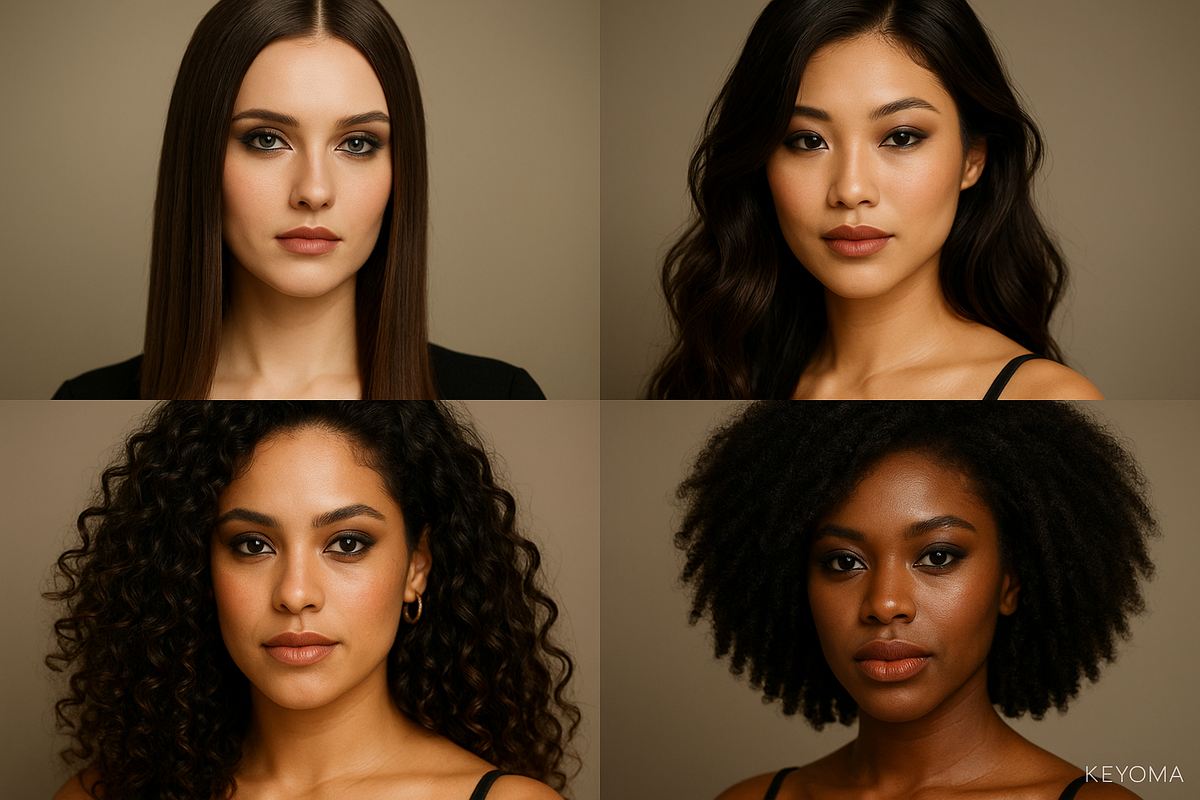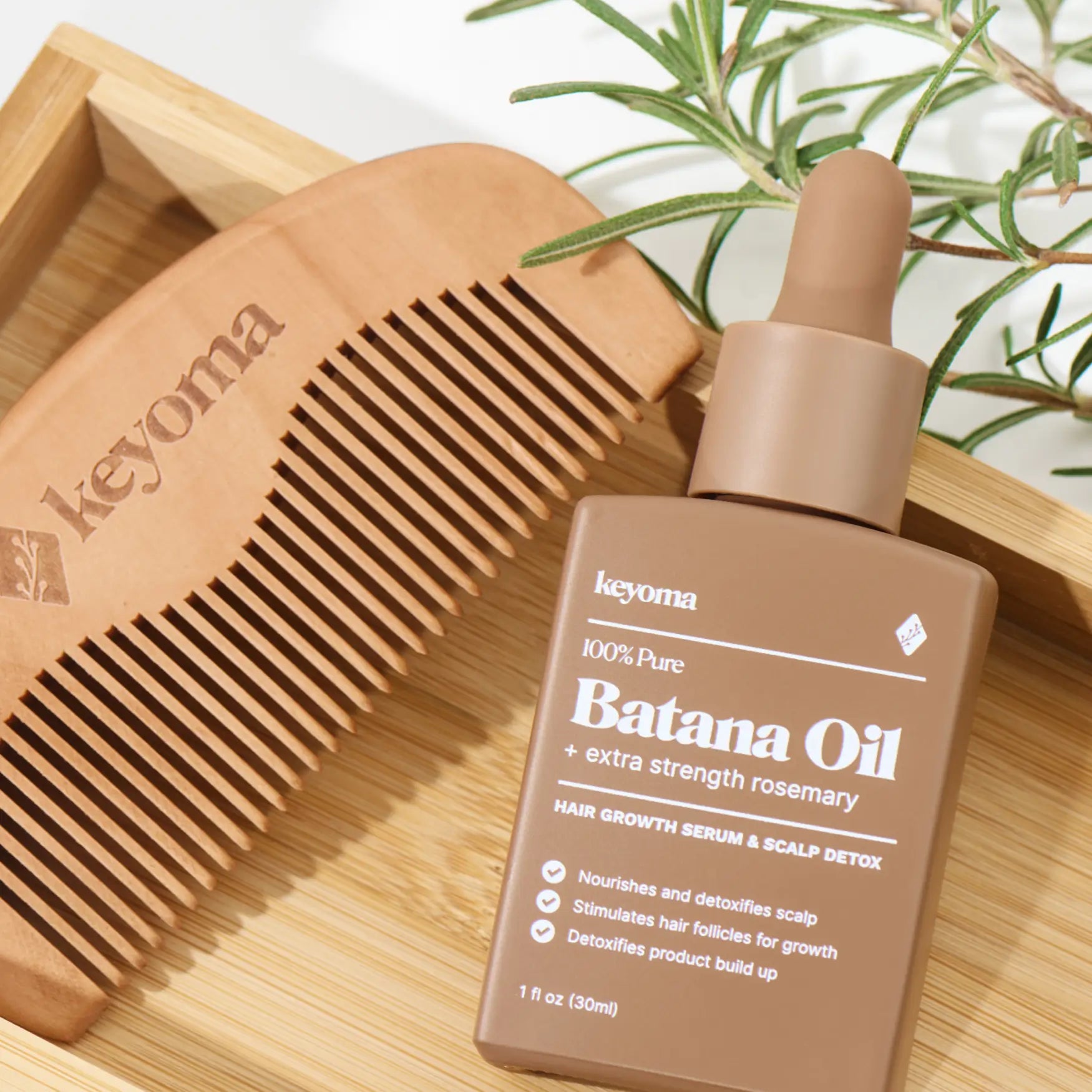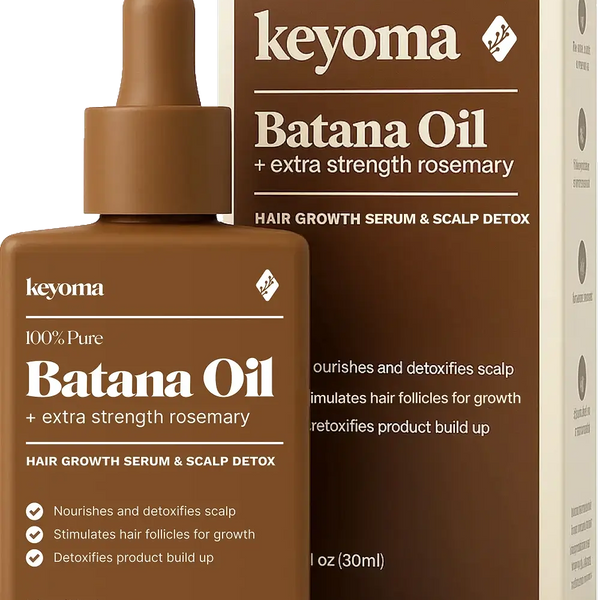In this article
The shape of your follicles, the way your strands grow, even how easily your scalp’s oils travel down the shaft—it’s all, for the most part, decided by genetics.
And yet, so many of us spend years guessing what our hair needs, buying whatever’s trending, and hoping something finally works, when we could just break free from that endless cycle of trial and error.
That’s why in this guide, I’ll walk you through the four main hair types, how to care for each one properly, and how to figure out what you’re really working with, so you can stop guessing and start building a routine that actually works.
Key Takeaways
-
Knowing your hair type helps you skip trial and error and avoid using the wrong products.
-
Each hair type has unique needs, from moisture levels to styling techniques.
-
Understanding your curl pattern is a practical first step to building a routine that actually works.
What "Hair Type" Means
Hair type refers to the natural pattern, shape, and structure of your strands. If we zoomed in under a microscope, we’d find that the shape of your hair follicle largely determines how your hair grows.
Round follicles tend to produce straight hair, while oval or flat follicles create waves, curls, or coils. It's all written in your genetics. Just like eye color or skin tone, your hair type is inherited.
For this article, we’ll talk about hair types using the Andre Walker Hair Typing System, a widely used method among stylists that organizes hair into four main categories:
-
Type 1 (straight)
-
Type 2 (wavy)
-
Type 3 (curly)
-
Type 4 (coily)
As you’ll see later on, each type has its own subcategories (A to C)
However, it's far from being a perfect system. While originally meant to simplify how we describe hair, it's also been criticized for having racial overtones.
Still, setting that aside, it remains a useful starting point for understanding your hair’s natural behavior and what kind of care it responds best to.
Why Knowing Your Hair Type Matters
Do I really need to fuss about hair type? Yes. Absolutely.
Knowing your hair type is more than just obsessing over labels or categories. It's a roadmap that guides what products you should use, how often to wash your hair, which ingredients to avoid, and even how you should style or detangle it without making things worse.
Ignore it, and you might be feeding your hair with the wrong stuff.
Using a heavy oil on low-porosity fine strands, for example, can leave them limp and greasy, whereas skipping creams or butters on coily hair could mean constant dryness and breakage.
Ultimately, this helps you skip all that guesswork, so you're not constantly experimenting, risking damage, or wasting time and money on products that don’t suit your hair.
Other Interpretations of "Hair Type"
As I mentioned earlier, this article focuses on the Andre Walker Hair Typing System. That’s an important distinction to make because the term hair type often gets used in different ways. It’s not always just about curl pattern.
For the sake of clarity (and to set the boundary of what this article won’t dive into), other qualities that influence how your hair behaves include:
-
Porosity: How well your hair absorbs and retains moisture. High porosity dries quickly but loses moisture fast. Low porosity resists absorption and takes forever to dry.
-
Density: How closely packed your strands are on the scalp. You can have thick individual strands but low density, or fine strands with high density.
-
Texture: Refers to the thickness of each strand, namely, fine, medium, or coarse. Coarse strands are stronger but less flexible, while fine strands are more fragile.
-
Elasticity: How much your hair can stretch before snapping. Healthy hair stretches and returns to its shape without breaking.
-
Plasticity: Your hair’s ability to hold a new shape when styled or set. Hair with high plasticity holds curls or flat-ironed shapes longer.
We'll keep our main focus on curl type throughout this guide, but keep in mind that these other traits often explain why two people with the same hair type still need completely different routines.
The 4 Main Hair Types

Type 1: Straight Hair
Straight hair lies flat from root to tip. Because there are no bends or curves, the scalp’s natural oils can travel freely along the strand, which explains why straight hair tends to get oily faster than other types. It also reflects light more easily, giving it a shinier appearance.
There are three subtypes within Type 1:
-
Type 1A: Very fine, soft, and flat with little to no body. It's hard to curl and often falls limp.
-
Type 1B: Still straight, but with more volume and a slight bend. It can hold styles better than 1A.
-
Type 1C: Straight but coarse and thicker. More resistant to styling, with a tendency to frizz in humidity.
Type 2: Wavy Hair
Wavy hair sits in that in-between zone, where it's neither completely straight nor fully curly. It has a loose, S-shaped pattern that often starts mid-shaft and gets more defined toward the ends. And while it usually looks soft and tousled, it can also frizz up fast, especially in humid weather.
The subtypes within Type 2 include:
-
Type 2A: Fine, thin, and barely wavy. It's easy to straighten, but struggles to hold a curl.
-
Type 2B: A bit more defined S-waves with some frizz. It tends to lie flatter at the crown, but picks up volume toward the ends.
-
Type 2C: Thick, coarse, and more resistant to styling. Waves begin closer to the roots and may even form loose curls.
Type 3: Curly Hair
Curly hair forms distinct loops or spirals that can range from loose ringlets to tighter corkscrews. Unlike wavy hair, the curl pattern in Type 3 usually starts at the root or very close to it.
These strands curve away from the scalp in all directions, which makes them more prone to dryness, frizz, and shrinkage.
The three subtypes under Type 3 are as follows:
-
Type 3A: Big, loose curls with lots of shine. These curls are springy and well-defined but can lose shape quickly with humidity or rough handling.
-
Type 3B: Medium to tight curls with more volume and less natural shine.
-
Type 3C: Tight, dense corkscrew curls. Sometimes confused with coily hair, 3C strands are thick, textured, and need intense hydration to reduce shrinkage and breakage.
Type 4: Coily Hair
Coily hair, also called kinky or afro-textured hair, grows in tight zig-zag patterns or very small coils. This type of hair is the most fragile of all curl types because each bend in the strand is a weak point—and there are a lot of bends!
It also experiences the most shrinkage, meaning your true length may look drastically shorter when dry.
Below are the subtypes within Type 4:
-
Type 4A: Soft, small coils with a clear S-pattern when stretched. It’s springy and holds moisture better than the other subtypes.
-
Type 4B: Less defined curls that bend more in a sharp Z-shape than a curve. This hair is fluffy and soft but dries out quickly.
-
Type 4C: The tightest, most delicate pattern. Strands are densely packed, with little to no definition without styling. This hair type is prone to breakage and can shrink up to 75% of its actual length.
Hair Care Do's and Don'ts Depending on Hair Type
Taking Care of Straight Hair
Straight hair, by nature, lies flat and smooth. This gives it a naturally sleek, shiny appearance, but it also means the scalp's oils travel down faster, making it more prone to greasiness.
Another challenge? It often lacks volume and gets weighed down by heavy products. And when paired with fine texture, it can break easily if brushed roughly or overwashed.
To help manage those tendencies, here are some simple do’s and don’ts:
-
Watch for oil buildup. Use a gentle, sulfate-free shampoo 2–3 times a week—or more if needed—and clarify weekly to avoid scalp congestion.
-
Go light on products. Thick creams and heavy oils will weigh straight hair down. Opt for lightweight leave-ins, mists, or water-based serums.
-
Add volume at the roots. If your hair tends to lie flat, try root-lifting sprays or blow-dry upside down to create lift without teasing or backcombing.
-
Brush regularly but gently. Daily brushing helps redistribute scalp oils and reduces dryness at the ends, but always use a soft bristle brush or a wide-tooth comb to avoid tugging.
-
Avoid over-conditioning. Apply conditioner only to the mid-lengths and ends to prevent limpness or flat roots.
Taking Care of Wavy Hair
Wavy hair tends to frizz, especially in humidity. It often falls flat at the roots, lacks consistent definition, and can get weighed down easily with heavy products.
Unlike curls, waves don’t clump as tightly, so brushing or over-handling can disrupt their pattern fast. Here’s how to care for it:
-
Don’t brush it dry. Brushing breaks up the wave pattern and creates frizz. Detangle gently in the shower with conditioner and a wide-tooth comb.
-
Use lightweight stylers. Mousses, foams, and light gels help enhance shape without weighing the hair down.
-
Avoid heavy oils and butters. They can flatten the wave and make the hair look greasy. Stick to water-based or lightweight hydrators.
-
Scrunch and plop. These techniques help your waves form better and stay defined as they dry.
-
Air dry or diffuse with care. If you’re using a blow dryer, use a diffuser on low to medium heat to avoid frizz.
-
Clarify as needed. Product buildup can easily weigh down waves, so add a clarifying wash every few weeks to reset your strands.
Taking Care of Curly Hair
Curly hair tends to be drier, more porous, and more fragile than wavy or straight types. It frizzes easily, shrinks as it dries, and needs more structure to hold its shape. Without enough moisture and proper handling, curls can look undefined, puffy, or break off at the ends.
Here’s how to care for it:
-
Avoid brushing when dry. It breaks up curl clumps and causes frizz. Detangle gently with fingers or a wide-tooth comb while hair is wet and coated in conditioner.
-
Moisturize in layers. Start with a leave-in conditioner, follow with curl cream, and seal with a gel or light hair oil.
-
Deep condition weekly. This keeps strands elastic and reduces breakage.
-
Use a microfiber towel or t-shirt to dry. Regular towels cause too much friction and lead to frizz.
-
Diffuse on low or air-dry. High heat disrupts curl structure. A diffuser helps curls dry in place with minimal disruption.
-
Sleep with protection. Use a satin bonnet or pillowcase to reduce overnight frizz and preserve curl shape.
Taking Care of Coily Hair
Coily hair is the most delicate and prone to breakage due to its tightly packed curl pattern. It loses moisture quickly, tangles easily, and shrinks significantly when dry. This type needs regular moisture, low-manipulation styling, and gentle handling at every step.
Here’s what helps:
-
Moisturize consistently. Use the LOC (liquid, oil, cream) or LCO method to layer hydration and seal it in.
-
Co-wash when possible. Frequent shampooing can strip moisture. Use cleansing conditioners or gentle shampoos between deep cleans.
-
Use protective styles. Twists, braids, or low-manipulation updos reduce breakage and lock in moisture.
-
Detangle gently. Always detangle damp hair with plenty of conditioner and start from the ends upward.
-
Avoid tight styles. These put tension on your edges and roots, which can lead to traction alopecia over time.
-
Trim regularly. Removing split ends prevents them from traveling up the hair shaft and causing more damage.
How to Identify Your Hair Type
As we discussed earlier, your hair type influences everything from your wash routine to what products you actually need. But what if you’re still unsure where your hair fits in? Here’s how to figure it out:
-
Start with clean, product-free hair. Wash and air-dry your hair without applying any stylers, creams, or leave-ins. That gives you a neutral baseline to observe your hair’s natural behavior.
-
Look at the shape of your strands.
-
Straight hair lies flat with no wave or curl.
-
Wavy hair forms loose S-patterns.
-
Curly hair creates distinct spirals or ringlets.
-
Coily hair forms tight curls or zig-zag shapes.
-
Check your roots to ends. You might have different patterns across your head, say, looser waves at the back and tighter coils at the crown. That’s completely normal.
-
Notice how your hair reacts to water and product. Does it frizz up instantly? Soak up moisture quickly or resist it? These clues help confirm your texture and porosity, which often influence how your curl pattern shows up.
-
Compare with reference images or talk to a stylist. Sometimes, it helps to match your hair against clear examples. And if you're still unsure, a licensed stylist can usually tell within minutes.
Again, hair typing isn’t a rigid label. It’s a tool to help you understand what your strands naturally need. Over time, your hair might even shift due to heat damage, age, or hormones, so it’s okay to reassess as needed.
Final Thoughts on Hair Types and How to Care for Them
When you understand your natural hair type or pattern, you stop guessing and start choosing products and habits that actually work.
You protect your hair from unnecessary damage and save yourself the time (and money) spent trying things that were never meant for your hair in the first place.
I have thick, wavy hair myself, probably somewhere between 2B and 2C. As part of my care routine, I wash with a sulfate-free shampoo, condition mid-length to ends, scrunch in a lightweight cream, and let it air-dry. And almost daily, I massage a few drops of rosemary-infused batana oil into my scalp.
So, how about you? Are you working with straight, curly, coily, or somewhere in between?
If you're curious about what else you can do to take better care of your hair, the Keyoma Blog is packed with free routines, practical tips, and everyday guides. Head there next and let your hair thank you later!
Featured Product
100% Pure Batana Oil + Rosemary









